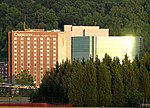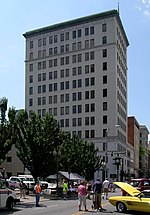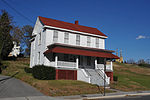Roanoke station (Virginia)
2017 establishments in VirginiaAmtrak stations in VirginiaBuildings and structures in Roanoke, VirginiaFormer Norfolk and Western Railway stationsRailway stations in the United States closed in 1971 ... and 5 more
Railway stations in the United States closed in 1979Railway stations in the United States opened in 1857Railway stations in the United States opened in 1975Railway stations in the United States opened in 2017Transportation in Roanoke, Virginia

Roanoke station is a train station in Roanoke, Virginia, the current southern terminus of Amtrak's Northeast Regional line. Built in 2017, it follows several other Roanoke passenger stations that operated from the 1850s to 1979. The unstaffed station consists of a single high-level platform with no station building or waiting room available for passengers. All tickets must be purchased in advance; there is no Quik-Trak kiosk at the station.
Excerpt from the Wikipedia article Roanoke station (Virginia) (License: CC BY-SA 3.0, Authors, Images).Roanoke station (Virginia)
Martin Luther King Junior Memorial Bridge, Roanoke
Geographical coordinates (GPS) Address Nearby Places Show on map
Geographical coordinates (GPS)
| Latitude | Longitude |
|---|---|
| N 37.273269444444 ° | E -79.942347222222 ° |
Address
Martin Luther King Junior Memorial Bridge
Martin Luther King Junior Memorial Bridge
24011 Roanoke
Virginia, United States
Open on Google Maps










